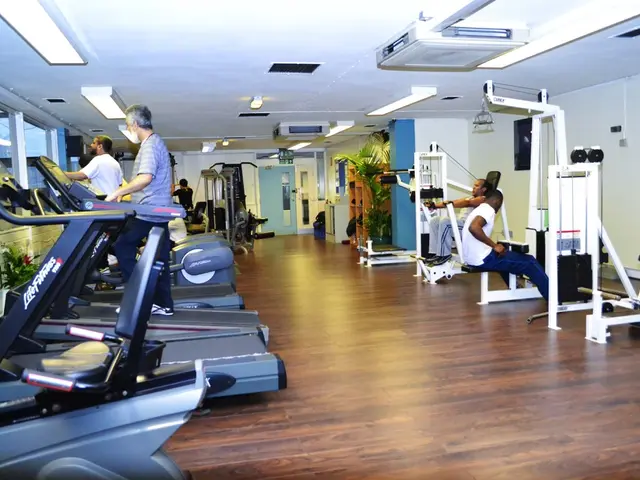Fibromyalgia and Physical Activity: Building Strength and Alleviating Pain Through Exercise
Fibromyalgia, a medical condition characterised by chronic pain and mental distress, affects millions of people worldwide. Recent scientific studies and expert recommendations have highlighted the significant role that exercise and physiotherapy play in managing the symptoms of this condition.
Aerobic exercise and resistance training have emerged as the most effective forms of exercise for fibromyalgia patients. These exercises have been shown to reduce pain, improve physical function, and enhance overall quality of life. Aerobic exercises, such as running or walking, can be particularly beneficial, while low-impact options like swimming are suitable for those concerned about strain on muscles or joints.
Resistance training, on the other hand, helps build strength and counteract muscle weakness, which are common in fibromyalgia patients. It's important to start with low intensity and gradually increase, ensuring the exercise is tailored to avoid overdoing and worsening symptoms.
In addition to aerobic and resistance exercises, targeted physiotherapy interventions such as manual therapy (including myofascial release and connective tissue massage), lymphatic drainage, and Shiatsu have demonstrated significant and sustainable benefits. These therapies boost circulation, improve posture and mobility, stimulate natural painkillers (endorphins), calm the nervous system to reduce pain sensitivity, and empower patients with symptom management education.
Group-based physical exercise programs have shown promise for improving patient adherence and outcomes. By fostering social support, motivation, and accountability, these programs can help break the common cycle of fear of pain during exercise, which often leads to physical weakness and worsening symptoms.
Experts also emphasise the importance of pacing activities, avoiding repetitive strain or cold drafts that can exacerbate symptoms, and adopting mindful ergonomic practices to reduce muscle tension and fatigue.
A well-rounded, patient-centered exercise strategy, emphasising aerobic and resistance training, supported by physiotherapy and careful pacing, is the most effective approach for fibromyalgia patients according to current scientific evidence and expert guidance.
While exercise can help with other fibromyalgia symptoms such as depression, difficulty concentrating, and sleep problems, more research is necessary to confirm these benefits. It's important to discuss any alternative and complementary remedies, such as acupuncture, massage, special diets, and other therapies, with a doctor before trying them.
Combining several treatments, including exercise, medication, therapy, stress management, and managing triggers, may offer the best results for people with fibromyalgia. For instance, Tai Chi, an ancient martial art originating from China, has shown promise in helping with both the physical and psychological symptoms of fibromyalgia.
Yoga, another accessible exercise option, can help prevent chronic pain by strengthening muscles, preventing muscle wasting, and reducing muscle damage. It may also reduce self-perceived disability and help with many fibromyalgia symptoms, including depression and fear or avoidance of movement.
The CDC recommends that adults aim for at least 150 minutes of medium intensity exercise or 75 minutes of high intensity activity per week. People with fibromyalgia may wish to start slowly and gradually increase the amount of time they spend exercising once they have identified a type of exercise that they find helpful and enjoyable.
In conclusion, a comprehensive approach that includes exercise, physiotherapy, and careful pacing is the most effective approach for managing fibromyalgia symptoms according to current scientific evidence and expert guidance. It's always crucial to consult a doctor before starting a new exercise regimen, particularly for those with movement limitations.
- Beyond fibromyalgia, other musculoskeletal disorders, chronic diseases like chronic kidney disease, COPD, and type-2 diabetes, and mental health conditions such as depression, can also benefit from fitness and exercise.
- Weight loss, a common goal in managing these conditions, can be facilitated through a balanced diet and regular physical activity, but it's essential to consult a medical professional before starting any weight loss program.
- Therapies and treatments like Tai Chi, yoga, acupuncture, and massage, in addition to medication and therapy sessions, can be beneficial in managing chronic-diseases and their symptoms.
- Health and wellness experts advise that nutrition plays a crucial role in managing these medical conditions, with a focus on whole foods and a balanced diet.
- Exercise, fitness-and-exercise programs, and physiotherapy are equally important in managing chronic rheumatoid arthritis, ensuring better mobility, reduced pain, and improved quality of life.
- Group-based exercise programs are not just beneficial for fibromyalgia patients, but also for individuals dealing with these other medical-conditions, fostering social support, motivation, and accountability.
- Incorporating wellness practices like mindful ergonomics, pacing activities, and avoiding aggravating factors like repetitive strain and cold drafts can help in managing symptoms and maintaining overall health.
- The medical community underscores the importance of science in understanding the benefits of various exercise forms, therapies, and treatments for these chronic diseases and mental health conditions.
- Lastly, it's crucial to consult a healthcare provider before embarking on any exercise regimen or alternate therapies, especially for individuals with movement limitations or existing health conditions.








